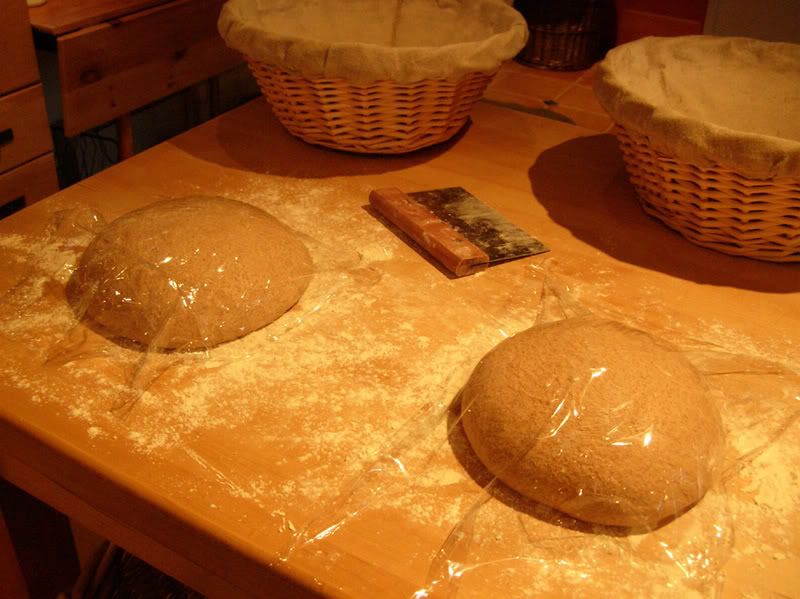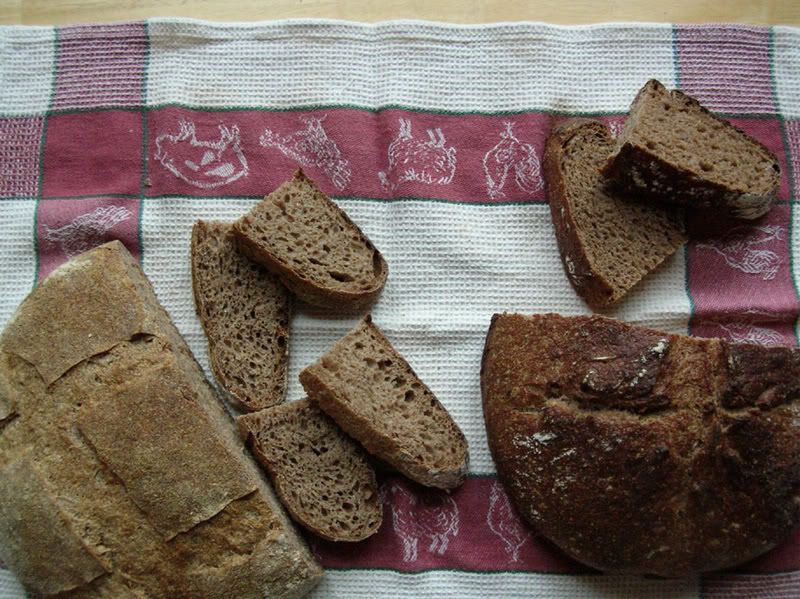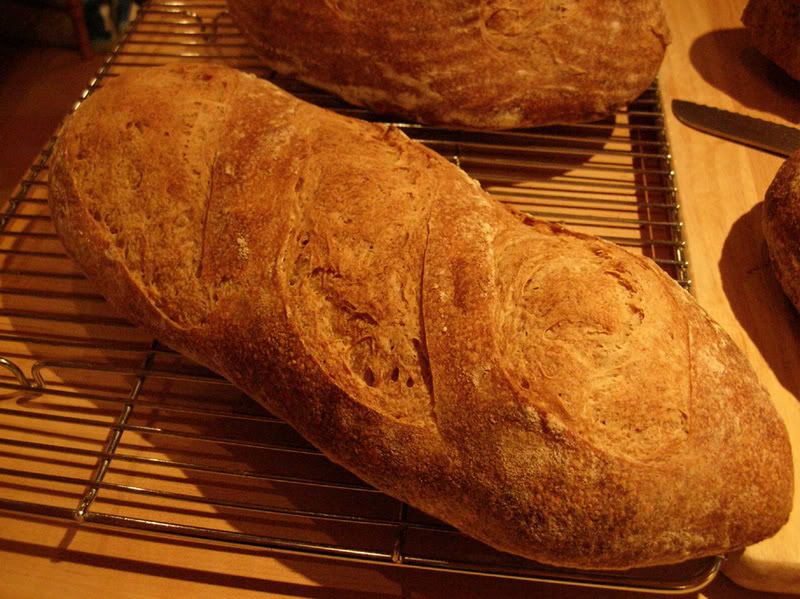
Better results for Whole Wheat Sourdough thanks to Jane and others
Seeing everyone make such beautiful whole grain breads lately inspired me last weekend to finally try Jane's lovely sourdough technique (Jane's results here), with tips by JMonkey and Tomsbread as well - thanks guys!
I converted some of my mixed white/WW starter into a 100% hydration WW starter, followed Jane's techniques and made a rather wet dough of about 80% hydration, kneading in my stand mixer for about 12-15 minutes on speed 2. I did not ferment the dough in the frig as Jane did though, I just left it in my cool room temp kitchen for maybe 3-4 hrs for the first ferment - it rose nicely. Then I divided the dough, rounded, rested for 10 minutes before placing in bannetons for final 80-85F proof near the woodstove (this was the day the big Nor'Easter started so we were getting 5 inches of wet snow, good reason to have a fire going and good weather to stay in and bake bread).

Since I had 2 loaves of rather wet dough, I decided to do a little experiment and bake one in my 5 qt cast iron Lodge dutch oven to hopefully keep it from spreading too much, while I baked the second one right on the hot baking stone after the first was done. I was surprised at some of the differences between the two. The loaf on the left in the photo below was baked on the preheated to 500F stone which was immediately turned down to 400F, and the one on the right was baked in the dutch oven at 450F entire time (lid removed after 25 min.):

I was surprised at how much darker the crust was on the dutch oven loaf. On the other hand, the dutch oven loaf did not rise much higher, probably because it sort of collapsed after an awkward flop into the oven from the banneton, hence the crumb was slightly more dense than the free-form loaf's crumb. I'll try the dutch oven again but try to be much more gentle in getting it into the oven, maybe using parchment like Susan did in her posts of her beautiful "football bread".
I am really happy with how the free-form loaf came out, the crumb was much hole-y-er than any 100% WW I've done so far, not as hole-y as Jane's, but next time I'll try an even higher hydration with a little more folding and see how that comes out. Seems like the key for me was wet wet dough and very very gentle handling - I didn't shape the boules as tight as I normally do, I kept them much looser.

This was also the best tasting WW sourdough I've made yet, it tasted better than the last desem I made. It had a nice tangy SD taste rather than a bitter wheat taste, probably from the long cool bulk ferment and also long warm final proof. In fact, the reason the second free-form loaf may be so much lighter is because it was slightly overproofed so the crust did not carmelize as much, but it still tasted very good and it lasted all week! We are still enjoying this loaf made last Sunday (5 days ago), it has stayed fresh-tasting and moist just sitting on the cutting board with a piece of foil covering the cut end. It did not get dried out and hard like other lean WW breads I've made before.
The same weekend, I also made a batch of Columbias and Leonard boules. I hadn't made the Columbias in awhile, and this time my batartd-shaping and slashing showed significant improvement over the last few times making this recipe, where the batards used to collapse at the slashes. Thats's thanks to Floyd's batard-shaping and slasher video! Giving the dough the extra folds also helped it get much better height and oven spring than my earlier attempts. These did not last the weekend and got eaten right away.



Comments
Wow, MountainDog, those are fantastic. I wonder if the looser starter helps make for a more open crumb? I remember reading in Hammelman's Bread that the wetter the pre-ferement, the more active the protease enzymes are, which, in turn, makes the dough more extensible.
I think I'm also not seeing as open a crumb as you and Jane because I'm having the same "Plop" problem with my cloche that you described with your dutch oven.
This weekend, barring some sort of unforseen something or other that I have to do, I'm going to try a varient on Tomsbread's method and pain a l'ancienne. Basically, mix up a very wet dough very cold with just 1/4 tsp yeast, let it sit in the fridge overnight, and then let it warm up and rise the next day with 3 or more folds. We'll see how it goes ....
Thanks JMonkey - reading all of your great blogs has been an education in whole grain baking for me. I didn't know that about the wet starter, I just always maintain wet starters as I find them a little easier. I have about 20 bread books but Hammelman's is not one of them, I'll have to check it out now! I plan to try Susan's parchment trick next time I use the dutch oven to avoid the plop and see if that helps. I look forward to seeing your next results with the yeast recipe. Happy baking...
jmonkey,
I have been fooling around with getting the dough into a cloche using parchment and it dawned on me that the best of both worlds was staring me in the face. I place the bell lid on the stone when I use one and warm both up. The dough goes on parchment and into the oven, then covered by the bell cover. I use the same time as the no knead (30 on 15 off) at 450-425. The steam is captured by the bell and gives the crust a little extra time to form.
I had gotten away from this method when I discovered that a stone and preheat isn't necessary but the best results for me have been using both a stone and preheat.
The glass bowl method Susan uses is also effective for me. Both give a great rise and open holey crumb. The long ferment using 100%WW has made a convert out of me. That tomsbread thread was an eye opener. Best WW bread I have ever eaten, baked under the bell.
Eric
Beautiful, just beautiful. I agree with JMonkey, they are inspiring!
Susan
VERY inspiring.
Really nice breads, I have to finally try 100% whole wheat. Did the two ww breads taste the same or was there a difference? Also, whose whole wheat flour did you use? Again, those are some delicious looking breads. weavershouse
Hi Weavershouse - I used King Arthur organic whole wheat flour. Both tasted similar, but I think the freeform loaf was a little tastier and softer, probably due to the more open crumb (not that it is particularly soft, it is still chewy...I have a sore tooth right now so lately I am sensitive to these hard chewy crusty loaves!). The dutch oven one had the nicer crust though - I'll try the dutch oven again but maybe proof a little longer and be more careful loading the dough. Thanks!
Wonderful whole wheat results. Thanks for sharing your notes, that is really helpful.
I am ever more interesting in trying more of these whole wheat breads. Yours are beautiful and it is killing me because we have to leave on vacation in a couple days and I do not have time to bake again.
I have a question though about WW. Is it supposed to be difficult to make whole wheat bread? I've only made Peter Reinhart's WW a couple times and it turned out really nice, except for the one loaf I failed to put in the oven with the other (duh) and it overproofed and fell. Also, I was not in love with the flavor or texture of that bread. Is that part of the difficulty I keep reading, to get a good flavor, or am I misunderstanding it being difficult at all? Help! I'm confused!
When I get back from vacation I am going to get right on this. I must make desem and these breads you've made are wonderful. I'm still not sure I like the idea of baking bread in a pot but I definately will branch out a bit from what I've been doing.
Your Columbia looks FABU! I just baked it again myself - I like to make it into 3 batards instead of 2 larger loaves. But, once again, my slashing just isn't good. I cannot understand what my problem is either.
(I should have also mentioned I've baked my grandmother's bread several times but it has a lot of white flour in addition to the graham flour.)
is that it can be pretty dicey to lift out of the doorstop stage, as near as I can ascertain this is because the sharp little edges of the bran cut the gluten strands and hamper rising. So the baker has to account for this, assuming they want something like a lofty loaf, either by adding white flour, gluten flour, or a preferment of one sort or another. Preferments also seem to mellow the flavor and texture, which are decidedly not to everyone's liking, and white whole wheat is naturally gentler on the palate. I have also heard that whole wheat is lower in gluten, but if it's ground from hard wheat I don't see why the gluten content would be any lower than comparable white, I'm sure one of the uber-breadoligists around here could address that in spades. The reputation for difficulty is earned when you try to make whole wheat flour behave like white flour, if you set out to work with it without modifying your technique or your expectations, I guess. Of course not everyone strives for altitude in whole wheat, plenty of folks prefer it gutsy. I have what can be called a recipe only by the broadest stretch of the imagination, for 'bread' made by blending 2 cups of sprouted wheat and frying or baking whatever it is you end up with.
I had never read that about the bran edges cutting the gluten. I thought that gluten was a bit tougher. I will take that to heart and give all this some thought.
I just tried some white whole wheat flour in a recipe, testing it for a friend, and I didn't care for it. First of all, it felt like sand, or more like semolina. It also wasn't white. I guess I was expecting something it could not deliver. I didn't feel it performed any better than regular whole wheat.
I would like to make a SD ww or near-ww that is simple and repeatable and fairly airy. Those little sharp bran pieces sure do cause a lot of trouble in baking. No wonder they got rid of 'em! I've seen that sprouted wheat 'recipe' but have not tried it. I've thought about sprouting some berries, drying and grinding them to see what would happen, but that certainly isn't simple. Maybe someone among us will come up with a recipe that will make us all happy!
There's a SDNK fermenting in the fridge. I put some www in it, but not enough to matter one way or the other. A quiet day here, a pot of Southwestern Chicken Barley Soup is on the stove. Hope my newfound linking ability works!
Best to all,
Susan
Nice job, mountaindog!
I just took my first ww loaf out of the oven this morning. It's not 100%, because I lost my nerve at the last minute and used 1/3 white, but next time it will be all ww.
I'd been reading JMonkey's talk of pain a l'ancienne style, and finally tried a hybrid; on Friday morning I mixed up the NYT no-knead recipe using 2 cups ww, 1 cup white, 1 5/8 cups ice water, 1/4 tsp yeast, 1 tsp salt. As soon as it was mixed, it went straight into the fridge where it remained until Saturday morning. I took it out, did three stretch and folds over 1 1/2 hours, then let it sit until about 7:00 in the evening (it took that long to warm up and ferment). I was not in the mood to stay up all night to bake it, so I shaped it and set it in it's cloth lined bowl and back into the fridge. This morning I took it out, set it in the oven with the pilot on, proofed for about 3 hours, then baked in the preheated pot (30 min covered, 20 open) at 450 F.
It came out looking exactly like the one you cooked in your dutch oven, right down to the dark crust and slight deflate from it's descent into the pot in the first place. The taste was the best thing I've ever done with yeast. I gave up on using a lot of ww years ago; just to sawdust-y, but this was sweet and chewy, much like the taste of the poor flat pain a l'ancienne I made a couple of weeks ago.
This whole super-long ferment thing is very cool! Now I just need to get my poor sourdough up and running again. It's close, but still kind of lazy...
edh